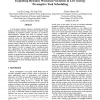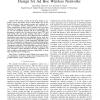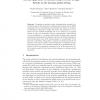412 search results - page 67 / 83 » Utility maximization in peer-to-peer systems |
110
Voted
DATE
2005
IEEE
15 years 6 months ago
2005
IEEE
A novel energy reduction strategy to maximally exploit the dynamic workload variation is proposed for the offline voltage scheduling of preemptive systems. The idea is to construc...
260
Voted
INFOCOM
2005
IEEE
15 years 6 months ago
2005
IEEE
Abstract— We present a model for the joint design of congestion control and media access control (MAC) for ad hoc wireless networks. Using contention graph and contention matrix,...
GECCO
2005
Springer
15 years 6 months ago
2005
Springer
A primary strength of the XCS approach is its ability to create maximally accurate general rules. In automatic target recognition (ATR) there is a need for robust performance beyo...
95
Voted
ANTSW
2004
Springer
15 years 6 months ago
2004
Springer
Designing an optimal overlay communication network for a set of processes on the Internet is a central problem of peer-to-peer (P2P) computing. Such a network defines membership a...
97
Voted
HICSS
2003
IEEE
15 years 5 months ago
2003
IEEE
We adopt the decision-theoretic principle of expected utility maximization as a paradigm for designing autonomous rational agents operating in multi-agent environments. We use the...



